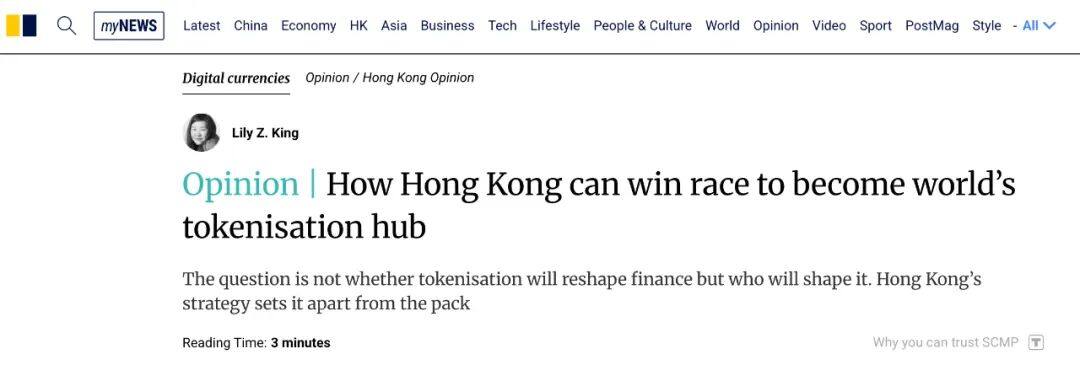Original author: Lily Z. King
Source: Cobo Global
Editor's Note: On July 3rd, the South China Morning Post website published an article by Cobo COO Lily Z. King, which provides an in-depth analysis of how Hong Kong is seizing an early lead in the global tokenization race. The article argues that as the tokenization of real-world assets (RWAs) accelerates into the mainstream, Hong Kong is building a new generation of financial infrastructure through a clear regulatory framework, an open market approach, and proactive policy innovation. The second half of this competition will hinge not on policy guidance but on whether products truly meet market demand.
Note: This article is translated from English for reference only. 

Lily Z.King at the Deloitte Digital Asset Forum in Hong Kong on July 8
Participants included officials from the Secretary for Financial Services and the Treasury, the Securities and Futures Commission, the Legislative Council, the Hong Kong Monetary Authority, and industry bodies.
When BlackRock Chairman Larry Fink wrote in his annual letter to shareholders, “Every stock, every bond, every fund—every asset can be tokenized,” he was not predicting some distant transformation but a shift that is already underway—an evolution that is reshaping how capital is formed, how assets are distributed, and how financial opportunity is accessed.
At the heart of this transformation lies a concept that was once niche but is now rapidly entering the mainstream: the tokenization of real-world assets (RWAs). Currently, over $24 billion in RWAs are circulating on public blockchains, encompassing yield-bearing US Treasury bonds, private credit pools, tokenized commodities, and real estate. What was once considered a "cryptocurrency experiment" is now becoming part of global financial infrastructure—the underlying infrastructure of capital markets is quietly being restructured.
So the question is no longer whether tokenization will reshape finance, but who will shape it.
In the “Digital Asset Development Policy Statement 2.0” released on June 26, Hong Kong expressed its intention to lead.
The announcement launched the “Leap” regulatory framework, expanding the scope of supervision to stablecoin issuers, custodians, and RWA platforms. More importantly, it sends a clear signal: Hong Kong is not just “allowing tokenization,” but actively promoting it.
"Leap" is an abbreviation for "Legal," "Expand," "Advance," and "People and Partnership." By developing a stablecoin licensing system, clarifying the regulatory framework for tokenized ETFs, and continuing previous pilot projects in digital bonds and green finance, it aims to promote a broader vision and encourage the tokenization of various assets, from precious metals to renewable energy infrastructure.
But perhaps the most significant change lies not in what the policy specifically regulates, but in how it defines tokenization—viewing it as a core pillar of new financial infrastructure rather than a sandbox experiment. This alone sets Hong Kong apart from other markets.
In contrast, Singapore has adopted a more cautious approach, focusing on institutional participation and restricting retail investors, while Hong Kong has chosen a broader and more inclusive path. It allows retail users to participate under the premise of setting clear suitability rules, thus expanding the potential market space.
Compared to the EU’s prescriptive cryptoasset market structure and the fragmented regulatory tug-of-war in the United States, Hong Kong offers a more unified, principles-based system that provides the clarity needed by innovators and investors.
However, simply laying the tracks doesn’t mean the trains will run on time. Issuing a tokenized asset is easy; the challenge lies in finding someone willing to hold, trade, and trust it.

Jeremy Allaire (third from left), CEO and co-founder of Circle Internet Group, one of the world's largest stablecoin issuers, and Heath Tarbert (second from left), President of Circle, at the New York Stock Exchange on the day of the company's initial public offering, June 5.
Photo: Reuters
Too many tokenized projects have learned this the hard way: the technology worked, but the market didn't buy in. Lacking distribution channels, market demand, or practical relevance, many products are ultimately shelved. The bottleneck isn't technology or regulation, but genuine commercial value. The true test is whether a tokenized asset truly solves a problem for a clearly defined user group.
Of course, some projects have passed this test and successfully scaled. For example, tokenized U.S. Treasury products have gained widespread adoption among savers around the world, especially in emerging markets where safe yields are scarce, due to their stable and transparent yields.
For example, protocols such as Maple Finance have opened up new paths in the private lending sector, making products bidirectional by matching institutional borrowers with crypto-native lenders and implementing transparent risk control on the chain.
These successes do not come from novel technology, but from the perfect match of assets, users and packaging methods.
Hong Kong's local ecosystem is also evolving in this direction. The Hong Kong Monetary Authority's "Project Ensemble" is experimenting with tokenized bonds, funds, carbon credits, charging station infrastructure, and supply chain finance. These projects have considerable potential, but a truly blockbuster project that can connect the three elements of assets, audiences, and use cases on a large scale has yet to emerge.
All the elements are in place; what's needed next is market traction. Hong Kong has laid a solid foundation: clear regulation, institutional recognition, and credible projects with public-private collaboration are steadily advancing. Hong Kong is increasingly recognized as a safe and structured environment for digital asset experimentation. This, coupled with its potential as a bridgehead for China's digital asset strategy, makes its significance far beyond the local market itself.
But the hardest part is just beginning. The next phase of competition will be determined by product-market fit, not policy. Can Hong Kong attract Southeast Asian savers to invest in truly profitable stablecoin products? Can it connect Chinese industrial assets to global capital through compliant digital packaging? Can it incubate a new generation of RWA products that are not only legal and compliant but also have real market demand?
These questions will determine whether RWAs are merely a trend or a lasting transformation; they will also determine whether Hong Kong can become the global tokenization capital of this new era. If successful, Hong Kong will not only be a leader but also a defining force in the future of finance.
- 核心观点:香港以监管创新抢占RWA代币化先机。
- 关键要素:
- 香港推出Leap框架扩大监管范围。
- 240亿美元RWA已在公链流通。
- 代币化美债等成功案例验证需求。
- 市场影响:推动香港成为全球代币化中心。
- 时效性标注:中期影响。



